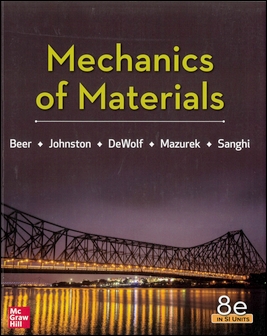書籍分類

Mechanics of Materials 8/e (SI Units)
作者:Ferdinand P. Beer, Jr. Johnston, John DeWolf, David Mazurek
原價:NT$ 1,600
ISBN:9789813158979
版次:8
年份:2020
出版商:McGraw-Hill
頁數/規格:896頁/平裝彩色
參考網頁:Critical Thinking: A Student's Introduction 6/e
版次:8
年份:2020
出版商:McGraw-Hill
頁數/規格:896頁/平裝彩色
參考網頁:Critical Thinking: A Student's Introduction 6/e
內容介紹 目錄
- Description
- Extensive use of Free-body Diagrams
- Sample problems explained with SMART Problem-Solving Methodology
- Ample number of Concept Applications
- More than 1500 homework problems including end of sections, review and computer problems
- Online lab videos with data sets
A strong conceptual understanding is essential for solving problems successfully. This edition of Mechanics of Materials helps instructors and students achieve this goal by providing strong understanding and logical analysis of the concepts using S/ units, which also helps identify the applications in designing actual engineering structures and machine components.
With new concepts presented in a simplified and detailed manner, a number of Advanced or Specialty sections are included. To keep these distinct and optional, these are marked with asterisk so users can choose whether or not to read. Using numerous engineering examples and end-of-chapter homework problems, the book helps the readers to easily understand and relate to theory and application.
McGraw Hill's Connect is available as an optional add on item. Connect is an integrated learning system that empowers students by continuously adapting to deliver exactly what they need, when they need it, and how they need it so that class time is more effective. Connect allows instructors to assign assignments and tests easily and automatically grades and records scores of the student's work.
HIGHLIGHTS
分類位置:
理工 > 機械工程 > 材料力學


